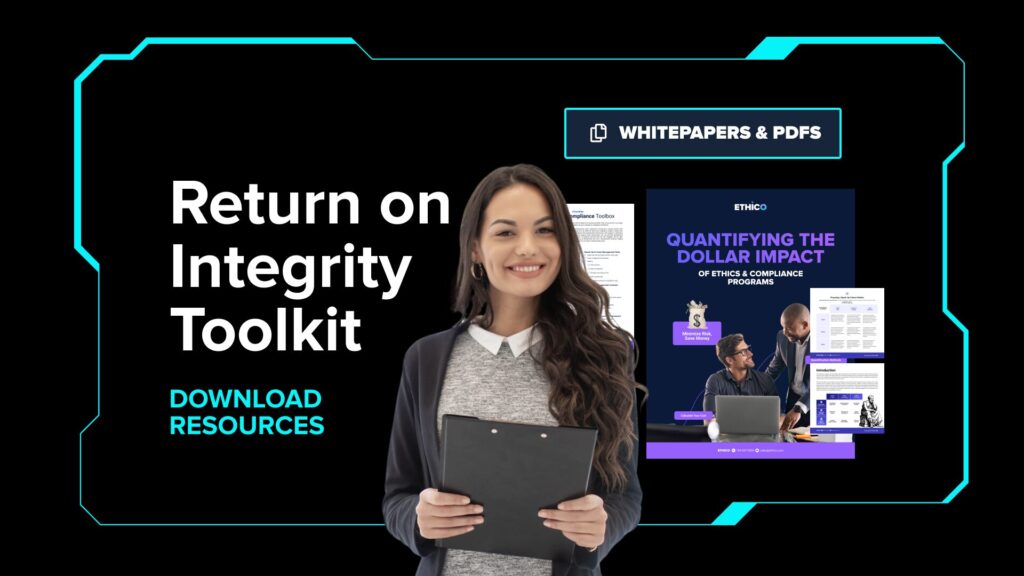EV Workshop: Calculate, Track, & Articulate Return on Integrity (ROI)


Full Episode Available
WATCH ON-DEMANDIn an era where ethics and compliance departments are often viewed as necessary overhead, this comprehensive webinar challenges conventional thinking by demonstrating how to quantify and articulate the true business value of integrity programs. Drawing from real-world experience in private equity and organizational transformation, the session provides practical frameworks for calculating return on investment (ROI), understanding personality-based persuasion techniques, and positioning ethics and compliance as strategic business drivers rather than cost centers.
This episode of The Ethicsverse explores the fundamental shift required for ethics and compliance professionals to transition from reactive cost centers to proactive growth engines within their organizations. Through a systematic examination of quantification methodologies, the session introduces the FORM framework (Financial, Operational, Risk, and Market factors) for identifying and measuring the multidimensional value created by ethics programs. The presentation integrates behavioral psychology principles, including personality type analysis and persuasion matrices, to enhance communication effectiveness with diverse stakeholders. Key concepts include the ethical equity premium demonstrated by consistently superior performance of ethical companies, practical ROI calculation methods with conservative estimation techniques, and advanced framing strategies such as pre-suasion and anchoring effects. The webinar provides actionable tools for professionals to speak the language of business, build credibility through data-driven arguments, and secure resources by demonstrating measurable impact on enterprise value.
- Nick Gallo, Chief Servant & Co-CEO, Ethico
- Andrew McBride, Founder & CEO, Integrity Bridge LLC
The Ethical Premium is Real and Measurable
- The “green line” of ethical companies consistently outperforms the market across all economic cycles, proving that integrity drives superior financial returns.
- This performance gap represents a quantifiable premium that ethics and compliance professionals can claim partial credit for through their programs and initiatives.
- By understanding that this premium exists in four key areas (Financial, Operational, Risk, and Market factors), practitioners can build compelling business cases that resonate with leadership.
Logic Makes You Think, Emotion Makes You Act
- While compliance professionals often over-index on logical arguments, successful persuasion requires a balanced approach incorporating ethos (credibility), pathos (emotion), and logos (logic).
- The most effective business cases combine hard data with compelling narratives that connect to personal values and organizational aspirations.
- Leaders make decisions based on emotional resonance first, then validate with logic – understanding this sequence transforms how we present our initiatives.
Beyond the Cost Center Mentality by Quantifying Third-Order Impacts
- Ethics and compliance create value through indirect, third-order impacts that ripple throughout the organization – from improved employee engagement to enhanced customer loyalty.
- These impacts are measurable through conservative estimation techniques, benchmarking, and expected value thinking.
- By quantifying benefits like reduced turnover costs, lower cost of capital, and productivity gains, departments can demonstrate ROI multiples of 3-30x on their investments.
Personality Type Awareness
- Understanding whether your audience is a Director (Type A), Socializer (Type B), Thinker (Type C), or Supporter (Type D) allows you to tailor your message for maximum resonance.
- Directors want bottom-line results and competitive advantage; Socializers seek recognition and team success; Thinkers need detailed analysis and risk mitigation; Supporters value stability and team protection.
- Matching your communication style to personality type can mean the difference between immediate approval and prolonged resistance.
Conservative Assumptions Build Credibility and Trust
- When calculating ROI, always err on the side of conservatism – use estimates at the low end of benchmark ranges, attribute only small percentages of outcomes to your initiatives, and present ranges rather than fixed projections.
- This approach builds trust with financially-minded executives who are trained to be skeptical of aggressive claims.
- When leaders think “it’s probably worth more than that,” you’ve achieved the optimal persuasive position.
The 3.0 Evolution: From Risk Mitigation to Strategic Value Creation
- The ethics and compliance profession is evolving from 1.0 (pain avoidance/keeping people out of jail) through 2.0 (efficiency/cost reduction) to 3.0 (effectiveness/profit expansion).
- Organizations at the 3.0 level integrate compliance into revenue-generating activities, with professionals joining sales calls and enabling premium pricing.
- This evolution requires shifting focus from reactive risk management to proactive value creation and business enablement.
Pre-suasion Sets the Stage for Success
- Effective influence begins before the formal ask through strategic pre-suasion – shaping how people perceive information before they encounter your proposal.
- This includes educating stakeholders about emerging risks months before budget requests, having allies introduce your expertise before presentations, and setting clear expectations about conversation outcomes.
- Like movie trailers that generate excitement before the film, pre-suasion creates receptivity to your message.
Continuous Improvement Unlocks Ongoing Investment
- Building trust requires demonstrating good stewardship through continuous improvement cycles – make initial investments, identify and eliminate bottlenecks, reduce maintenance costs, then redeploy savings to new initiatives.
- This approach, exemplified by keeping budgets flat while expanding program scope, proves business acumen and earns credibility for future requests.
- Document both successes and failures, showing willingness to pivot when initiatives don’t deliver expected value.
Leverage Behavioral Psychology for Maximum Impact
- Understanding cognitive biases like the anchoring effect (people rely heavily on first information presented) and the rule of three (optimal choice architecture) enhances persuasion effectiveness.
- Frame requests in context (“I’m not asking for $1 million, just $100,000”), provide three options with a clear recommendation, and use the 1-3-1 framework (one problem, three solutions, one recommendation) to reduce cognitive load and drive decisions.
Speaking the Language of Business
- Every other department presents budgets using ROI calculations, future projections, and business metrics – ethics and compliance must do the same to be taken seriously.
- This means moving beyond traditional metrics like training completion rates to focus on enterprise value drivers: revenue growth, cost reduction, risk mitigation, and market position enhancement.
- Mastering basic financial concepts and calculation methods isn’t just helpful – it’s essential for strategic influence.
Closing Summary
The transformation from cost center to growth engine requires a fundamental shift in how ethics and compliance professionals view and communicate their value. By embracing quantification, understanding human psychology, and speaking the language of business, practitioners can unlock resources, gain strategic influence, and drive meaningful organizational change. The tools and frameworks presented – from ROI calculation methods to personality-based persuasion techniques – provide a roadmap for elevating the profession. As the business landscape continues to evolve, those who master these skills will lead their organizations in capturing the ethical premium that creates sustainable competitive advantage. The next decade belongs to ethics and compliance professionals who can demonstrate, with clarity and conviction, that integrity isn’t just the right thing to do – it’s the smartest business strategy.






































